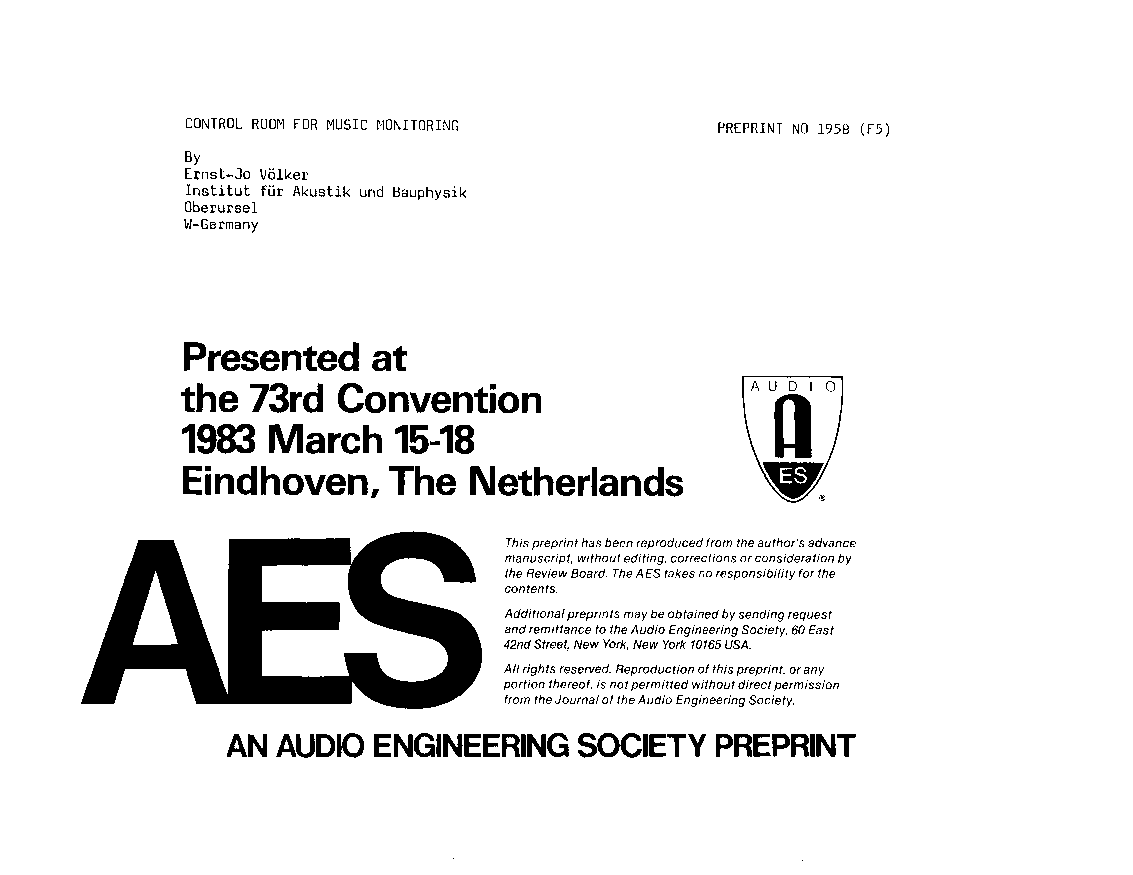Home / Publications / E-library page
You are currently logged in as an
Institutional Subscriber.
If you would like to logout,
please click on the button below.
Home / Publications / E-library page
Only AES members and Institutional Journal Subscribers can download
The quality of music reproduction in four different control rooms has been judged by 90 subjects. The test passages, the loudspeakers, the listening level, and the frequency response at the listening position have been kept constant. The aim of the tests is to determine the influence of the listening conditions of different control rooms. A short description of the four control rooms including the mean reverberation time is: 1) reverberant-0.7s; 2) semireverberant (system LEDE)-0.4s; 3) damped, almost reflection-free-0.2s; 4) like #3 but with 24 loudspeakers. The four conditions were constructed consecutively in a given control room space. In each case, the sound system was equalized for a listening position at the center of the control desk. A known, high-quality test tape of appropriate music recordings of different types was reproduced by the monitor loudspeakers and recorded at the listening position with an artificial head. The different room conditions could not be judged in A-B comparisons. The reverberant control room was preferred for chamber music and church organ, LEDE, got the most votes for the drum solo and disco music followed by the nonreverberant room. It follows that a compromise is necessary in the acoustic design of control rooms for use with ally types of music. This compromise is found in many existing control rooms for use with all types of music. This compromise is found in many existing control rooms where short-term reflections from widows, doors, equipment, and other furnishings give rise to a sense of reverberance. Control rooms for a specific use can follow a particular design. This study starts with an equalized loudspeaker system which is necessary for comparison between control rooms. The evaluation of control rooms for speech is under study at present; it is expected that some of the conditions of this test will not be suitable for speech.
Author (s): Völker, Ernst-Joachim
Affiliation:
Institut fur Akustik und Bauphysik, Oberursel, W-Germany
(See document for exact affiliation information.)
AES Convention: 73
Paper Number:1958
Publication Date:
1983-03-06
Import into BibTeX
Session subject:
Sound Reinforcement and Room Acoustics
Permalink: https://aes2.org/publications/elibrary-page/?id=11801
(1019KB)
Click to purchase paper as a non-member or login as an AES member. If your company or school subscribes to the E-Library then switch to the institutional version. If you are not an AES member Join the AES. If you need to check your member status, login to the Member Portal.

Völker, Ernst-Joachim; 1983; Control Rooms for Music Monitoring [PDF]; Institut fur Akustik und Bauphysik, Oberursel, W-Germany; Paper 1958; Available from: https://aes2.org/publications/elibrary-page/?id=11801
Völker, Ernst-Joachim; Control Rooms for Music Monitoring [PDF]; Institut fur Akustik und Bauphysik, Oberursel, W-Germany; Paper 1958; 1983 Available: https://aes2.org/publications/elibrary-page/?id=11801